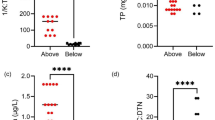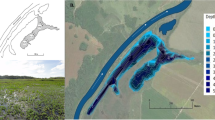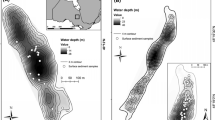Summary
Abiotic factors, standing crop and photosynthetic production were studied in the equatorial alkaline-saline closed-basin Lake Nakuru (cond. 10,000–160,000 μS). Meteorological conditions and abiotic factors offer suppositions for a high primary productivity: mean solar radiation is 450–550 kerg·cm-2·s-1, with little seasonal variation, regular winds circulate the lake every day and nutrient concentrations are usually high (>100 μg P−PO4·l-1). Oxygen concentrations near sediments were <1 gO2·m-3 for at least 6 h·d-1 in 1972/73, resulting in a release of ∼45 mg P−PO4·m-2·d-1. Attenuation coefficients vary from 3.6–16.5 according to algal densities and mean depth from 0–400 cm. Algal biomass was ∼200 g·m-3 (d.w.) in 1972/73, due to a lasting Spirulina platensis bloom (98.5% of algal biomass). In 1974 algal biomass suddenly dropped to 50 g·m-3 (d.w.). Spirulina and several consumer organisms almost vanished, but coccoid cyanobacteria, Anabaenopsis and diatoms increased. Several causes for this change in ecosystem structure are discussed. The use of the light/dark bottle method to measure photosynthetic production in eutrophic alkaline lakes is discussed and relevant experiments were done. Oxygen tensions of 2–35 gO2·m-3 do not influence primary production rates. Net photosynthetic rates (mgO2·m-3·h-1; photosynthetic quotient=1.18) reached 12–17.7 in 1972/73 and 2–3 in 1974, but vertically integrated rates were only 1–1.4 in 1972/73 and 0.8 in 1974, and daily net photosynthetic rates (gO2·m-3·24 h-1) 3.5 in 1972/73 and 1 in 1974. 50% of areal rates were produced within the 10 most productive cm of the depth profile. The disproportion between high algal standing crops and relatively low production rates is due to self-shading of the algae, reducing the euphotic zone to 35 cm in 1972/73 and 77 cm in 1974. Efficiency of light utilization is 0.4–2%, varying with time of day and phytoplankton density. In situ efficiencies show an inverse relationship to light intensities. Photosynthetic rates of L. Nakuru remain within the range of other African lakes (0.1–3 gO2·m-2·h-1). The relation of O2 produced/Chl a of the euphotic zone is 50% lower then in tropical African freshwater lakes and conforms to lakes of temperate regions.
Similar content being viewed by others
References
Andersen JM (1975) Influence of pH on the release of phosphorus from lake sediments. Arch Hydrobiol 76:411–419
Bourrelly P (1970) Les algues d'eau douse. III. Algues bleues et rouges. Boubée, Paris, 546 pp
Carpenter JH (1965) The Chesapeake Bay Institute technique for the Winkler dissolved oxygen method. Limnol Oceanogr 10:141–143
Cheney C, Hough RA (1982) Factors controlling photosynthetic productivity in a population of Cladophora fracta (Chloropyta). Ecology (in press)
Clément G (1975) Production et constituants caractéristiques des algues Spirulina platensis et maxima. Ann Nutr Alim 29:477–488
Colinvaux PA (1973) Introduction to ecology. J. Wiley & Sons, New York London Sidney Toronto, 621 pp
Curry-Lindahl K (1971) A short-term ecological survey of Lake Nakuru and the surrounding area. Mimeographed report, 29 pp
Compère P (1974) Algues de la region du Lac Tchad. II. Cyanophycées. Cah ORSTOM sér Hydrobiol 8:165–198
Dagg M, Woodhead T, Rijks DA (1970) Evaporation in East Africa. Bull Internat Ass Scientific Hydrol 15:61–67
Dokulil M (1971) Respiration and resistance against anaerobiosis of freshwater algae. Int Rev ges Hydrobiol Hydrogr 56:751–768
Douglass LJ (1975) Kinetics of oxygen production in Spirulina platensis in Lake Nakuru and some implications for primary productivity measurements in aquatic environments. B.Sc. thesis, Univ. of Michigan, Ann Arbor, 28 pp
Dubinsky Z, Berman T (1976) Light utilization efficiencies of phytoplankton in Lake Kinneret (Sea of Galilee). Limnol Oceanogr 21:226–230
Durant-Castel H, Clément G (1975) Spirulina Algae: Food for Tomorrow? Proc 9th int Congr Nutrition, Mexico, Vol. 3 S. Karger, Basel, 85–90
Ganf GG (1974a) Incident solar irradiance and underwater light penetration as factors controlling the chlorophyll content of a shallow equatorial lake (Lake George, Uganda). J Ecol 62:593–609
Ganf GG (1974b) Diurnal mixing and vertical distribution of phytoplankton in a shallow equatorial lake (Lake George, Uganda). J Ecol 62:611–629
Ganf GG, Horne AJ (1975) Diurnal stratification, photosynthesis and nitrogen fixation in a shallow equatorial lake (Lake George, Uganda). Freshw Biol 5:13–39
Ganf GG, Viner AB (1973) Ecological stability in a shallow equatorial lake (Lake George, Uganda). Proc Roy Soc Lond B 184:321–346
Gaudet JJ, Melack JM (1981) Major ion chemistry in a tropical African lake basin. Freshw Biol 11:309–333
Geitler L (1933) Cyanophyceae. Rabenhorst's Kryptogamenflora. Leipzig
Golterman HL, Clymo RS (1971) Methods for chemical analysis of fresh waters. IBP Handbook No. 8, Blackwell Scientific Publ., Oxford, 188 pp
Harris GP, Piccini BB (1977) Photosynthesis by natural phytoplankton populations. Arch Hydriobiol 80:405–457
Heckey RE, Kilham P (1973) Diatoms in alkaline, saline lakes: ecology and geochemical implications. Limnol Oceanogr 18:53–71
Holloway PE (1980) A criterion for thermal stratification in a wind-mixed system. J Phys Oceanogr 10:861–869
Huber-Pestalozzi G (1941–1961) Die Binnengewässer. Stuttgart
Hutchinson GE (1957) A treatise on limnology, vol 1. John Wiley & Sons, New York, 1015 pp
Iltis A (1970) Phytoplankton des eaux natronées du Kanem (Tchad). IV. Note sur les especes du genre Oscillatoria, sous genre Spirulina (Cyanophyta). Cah ORSTOM, sér Hydrobiol IV:129–134
Iltis A (1971) Note sur Oscillatoria (sous-genre Spirulina) platensis (Nordst.) Bourrelly (Cyanophyta) au Tchad. Cah. ORSTOM, sér Hydrobiol 1:51–73
Iltis A (1974) Phytoplankton des eaux natronées du Kanem (Tchad). VIII. Classification des milieux etudiés et espèces caractéristiques. Cah. ORSTOM, sér Hydrobiol 8:81–91
Jenkin PM (1936) Report on the Percy Sladen Expedition to some rift valley lakes in Kenya in 1929. VII. Summary of the ecological results with special references to the Alkaline Lakes. Ann Mag Hist Ser 10, 18:133–181
Jewson DH, Wood RB (1975) Some effects on integral photosynthesis of artificial circulation of phytoplankton through light gradients. Verh Int Ver Limnol 19:1037–1044
Källquist T (1977) Limnological investigation of lakes in Kenya 1976–1977. Ministry of Water Development, Nairobi. Mimeographed report, 6 pp
Kamau CK (1971) Late Quaternary lakes in the Nakuru-Elmenteita basin, Kenya. Geograph J 137:522–534
Kilham P (1971) Biochemistry of African Lakes and Rivers. Ph D Thesis, Duke University, Durham, 199 pp
Kosaric N, Nguyen HT, Bergougnou MA (1974) Growth of Spirulina maxima algae in effluents from secondary wastewater treatment plants. Biotech and Bioengineering 16:881–896
Leakey LSB (1931) East African lakes. Geograph Journal 77:497–514
LeBarbera MC, Kilham P (1974) The chemical ecology of copepod distribution in the lakes of East and Central Africa. Limnol Oceanogr 19:459–465
Lemoalle J (1981) Photosynthetic production and phytoplankton in the euphotic zone of some African and temperate lakes. Rev Hydrobiol trop 14:31–37
Livingstone DA (1975) Late-quaternary climatic changes in Africa. Ann Rev Ecol Syst 6:249–280
Lundberg A, Tallmark B (1973) Lake Naivasha och Lake Nakuru — en ekologisk jämförelse mellan två östafrikanska fågelsjöär. Fauna och Flora 68:1–15
MacIntyre S (1975) Ortho-phosphate concentrations in Kenyan lakes. American Soc of Limnol and Oceanogr, 39th Ann Meeting, Abstract
MacIntyre S (1978) Currents and turbulence in two African lakes. American Soc Limnol and Oceanogr, 41st Ann Meeting, Abstract
MacIntyre S (1981) Stratification and mixing in shallow tropical African lakes. PhD. thesis. Duke University, Durham, NC, 338 pp
Mann KH, Britton RH, Kowalczewski A, Lack TJ, Mathews CP, McDonald J (1972) Productivity and energy flow at all trophic levels in the River Thames, England. In: Kojak Z, Hillbricht-Ilkowska A (eds) Productivity Problems of Freshwater. IBP-UNESCO Symposium, PW Polish Scientific Publishers, Warsaw
McCall GJH (1967) Geology of the Nakuru — Thompson's Falls — Lake Hannington Area. Geolog Surv of Kenya. Report No. 78, 122 pp
Melack JM (1976) Limnology and dynamics of phytoplankton in equatorial African lakes. PhD thesis. Duke Univ Durham, NC, 453 pp
Melack JM (1978) Photosynthesis and growth of Spirulina platensis (Cyanophyta) in an equatorial lake (Lake Simbi, Kenya). Limnol Oceanogr 24:753–760
Melack JM (1979) Photosynthetic rates of four tropical African freshwaters. Freshwater Biol 9:555–571
Melack JM (1981) Photosynthetic activity of phytoplankton in tropical African soda lakes. Hydrobiol 81:71–85
Melack JM, Kilham P (1974) Photosynthetic rates of phytoplankton in East African alkaline saline lakes. Limnol Oceanogr 19:743–755
Milbrink G (1977) On the limnology of two alkaline lakes (Nakuru and Naivasha) in the East Rift Valley System in Kenya. Int Rev ges Hydrobiol 62:1–17
Morel A, Smith RC (1974) Relation between total quanta and total energy for aquatic photosynthesis. Limnol Oceanogr 19:591–600
Nilsson E (1931) Quaternary glaciations and pluvial lakes in British East Africa. Geogr Ann 13:249–348
Nimira JK (1976) Estimation of evaporation over Lake Nakuru using the aerodynamic energy budget, Penman and water budget methods. PhD thesis. Univ of Nairobi, Dept of Meteorology
Odum EP (1971) Fundamentals of ecology. Saunders Comp, Philadelphia
Odum HT, Hoskin CM (1958) Comparative studies on the metabolism of marine waters. Publ Inst Mar Sci Texas 5:16–46
Ogawa T, Terui G (1970) Studies on the growth of Spirulina platensis (I) On the pure culture of Spirulina platensis. J Ferm Technol 48:361–367
Penman HL (1948) Natural evaporation from open waters, bare soil and grass. Proc Roy Soc A 193:120–145
Peters RH, MacIntyre S (1976) Orthophosphate turnover in East African lakes. Oecologia 25:313–319
Rich F (1932) Reports on the Percy Sladen Expedition to some rift valley lakes in Kenya in 1929. IV. Phytoplankton from the rift valley lakes in Kenya. Ann Mag Nat Hist 10:233–263
Richardson JL, Richardson AE (1972) History of an African rift lake and its climatic implications. Ecol Monogr 42:499–534
Soeder CF (1976) Zur Verwendung von Mikroalgen für Ernährungszwecke. Naturwissenschaften 63:131–138
Smith RC (1969) An underwater spectral irradiance collector. J Mar Res 27:341–351
Szeicz G (1968) Measurement of radiant energy. In: Wadsworth RM (ed) The measurement of environmental factors in terrestrial ecology. Blackwell Scientific Publications, Oxford
Talling JF (1957a) Photosynthetic characteristics of some freshwater plankton diatoms in relation to underwater radiation. New Phytol 56:29–50
Talling JF (1957b) The phytoplankton population as a compound photosynthetic system. New Phytol 56:133–149
Talling JF (1957c) Diurnal changes of stratification and photosynthesis in some tropical African waters. Proc R Soc Lond B 147:57–83
Talling JF (1965a) The photosynthetic activity of phytoplankton in East African Lakes. Int Rev ges Hydrobiol 50:1–32
Talling JF, Talling IB (1965) The chemical composition of African lake water. Int Rev ges Hydrobiol 50:421–463
Talling JF, Wood RB, Prosser MV, Baxter RM (1973) The upper limit of photosynthetic productivity by phytoplankton: evidence from Ethiopian soda lakes. Freshwater Biol 3:53–76
Tilzer MM, Goldman CR, Amezaga E de (1975) The efficiency of photosynthetic light energy utilization by lake phytoplankton. Verh Internat Verein Limnol 19:800–807
Tyler JE (1975) The in situ quantum efficiency of natural phytoplankton populations. Limnol Oceanogr 20:976–980
Vareschi E (1978) The ecology of Lake Nakuru (Kenya). I. Abundance and feeding of the lesser flamingo. Oecologia 32:11–35
Vareschi E (1979) The ecology of Lake Nakuru (Kenya). II. Biomass and spatial distribution of fish (Tilapia grahami Boulenger = Sarotherodon alcalicum grahami Boulenger). Oecologia 37:321–335
Vareschi E, Melack JM, Kilham P (1981) Saline water. In: Symoens JJ, Burgis MJ, Gaudet JJ (eds) The ecology and utilization of African inland waters. UNEP Reports and Proceedings Series, Nairobi, 93–102
Viner AB (1975) The sediments of Lake George (Uganda) I. Redox potentials, oxygen consumption and carbon dioxide output. Arch Hydrobiol 76:181–197
Viner AB, Smith IR (1973) Geographical, historical and physical aspects of Lake George. Proc R Soc Lond B 184:235–270
Vogler P (1965) Probleme der Phosphatanalytik in der Limnologie und ein neues Verfahren zur Bestimmung von gelöstem Orthophosphat neben kondensierten Phosphaten und organischen Phosphorsäureestern. Int Rev ges Hydrobiol 50:33–48
Vollenweider RA (1971) A manual on methods for measuring primary production in aquatic environments. IBP Handbook No 12. Blackwell, Oxford and Edinburgh, 213 pp
Walker KF (1973) Studies on a saline lake ecosystem. Austr J Mar Freshw Res 24:21–71
Walker KF, Williams WD, Hammer UF (1970) The Miller method for oxygen determination applied to saline lakes. Limnol Oceanogr 15:814–815
Washbourn-Kamau CK (1970) Late quaternary chronology of the Nakuru-Elmenteita basin, Kenya. Nature 226:253–254
Williams WD (1972) The uniqueness of salt lake ecosystems. In: Kajak Z, Hillbricht-Ilkowska A (eds) Productivity Problems of Freshwater. Warshaw, pp 349–361
Williams WD (ed) (1979) Athalassic (inland) salt lakes. Proc First Int Symp, Adelaide, Australia
Winberg GG (ed) (1971) Symbols, units and conversion factors in studies of freshwater productivity. IBP Central Office, London, pp 23
Author information
Authors and Affiliations
Rights and permissions
About this article
Cite this article
Vareschi, E. The ecology of Lake Nakuru (Kenya). Oecologia 55, 81–101 (1982). https://doi.org/10.1007/BF00386722
Received:
Issue Date:
DOI: https://doi.org/10.1007/BF00386722




